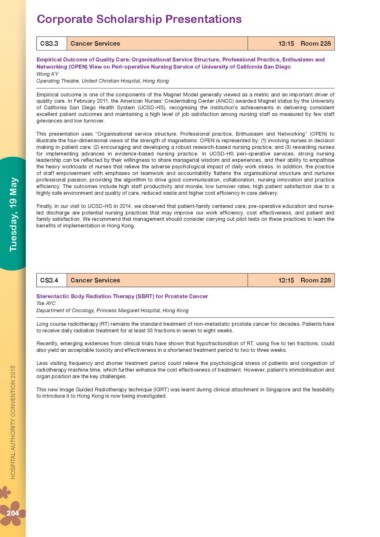Page 206 - HA Convention 2015
P. 206
Corporate Scholarship Presentations
CS3.3 Cancer Services 13:15 Room 228
Tuesday, 19 May Empirical Outcome of Quality Care: Organisational Service Structure, Professional Practice, Enthusiasm and
Networking (OPEN) View on Peri-operative Nursing Service of University of California San Diego
Wong KY
Operating Theatre, United Christian Hospital, Hong Kong
Empirical outcome is one of the components of the Magnet Model generally viewed as a metric and an important driver of
quality care. In February 2011, the American Nurses’ Credentialing Center (ANCC) awarded Magnet status by the University
of California San Diego Health System (UCSD-HS), recognising the institution’s achievements in delivering consistent
excellent patient outcomes and maintaining a high level of job satisfaction among nursing staff as measured by few staff
grievances and low turnover.
This presentation uses “Organisational service structure, Professional practice, Enthusiasm and Networking” (OPEN) to
illustrate the four-dimensional views of the strength of magnetisms. OPEN is represented by: (1) involving nurses in decision
making in patient care; (2) encouraging and developing a robust research-based nursing practice; and (3) rewarding nurses
for implementing advances in evidence-based nursing practice. In UCSD-HS peri-operative services, strong nursing
leadership can be reflected by their willingness to share managerial wisdom and experiences, and their ability to empathise
the heavy workloads of nurses that relieve the adverse psychological impact of daily work stress. In addition, the practice
of staff empowerment with emphases on teamwork and accountability flattens the organisational structure and nurtures
professional passion, providing the algorithm to drive good communication, collaboration, nursing innovation and practice
efficiency. The outcomes include high staff productivity and morale; low turnover rates; high patient satisfaction due to a
highly safe environment and quality of care, reduced waste and higher cost efficiency in care delivery.
Finally, in our visit to UCSD-HS in 2014, we observed that patient-family centered care; pre-operative education and nurse-
led discharge are potential nursing practices that may improve our work efficiency, cost effectiveness, and patient and
family satisfaction. We recommend that management should consider carrying out pilot tests on these practices to learn the
benefits of implementation in Hong Kong.
CS3.4 Cancer Services 13:15 Room 228
HOSPITAL AUTHORITY CONVENTION 2015 Stereotactic Body Radiation Therapy (SBRT) for Prostate Cancer
Tse AYC
Department of Oncology, Princess Margaret Hospital, Hong Kong
Long course radiotherapy (RT) remains the standard treatment of non-metastatic prostate cancer for decades. Patients have
to receive daily radiation treatment for at least 35 fractions in seven to eight weeks.
Recently, emerging evidences from clinical trials have shown that hypofractionation of RT, using five to ten fractions, could
also yield an acceptable toxicity and effectiveness in a shortened treatment period to two to three weeks.
Less visiting frequency and shorter treatment period could relieve the psychological stress of patients and congestion of
radiotherapy machine time, which further enhance the cost effectiveness of treatment. However, patient’s immobilisation and
organ position are the key challenges.
This new Image Guided Radiotherapy technique (IGRT) was learnt during clinical attachment in Singapore and the feasibility
to introduce it to Hong Kong is now being investigated.
204

